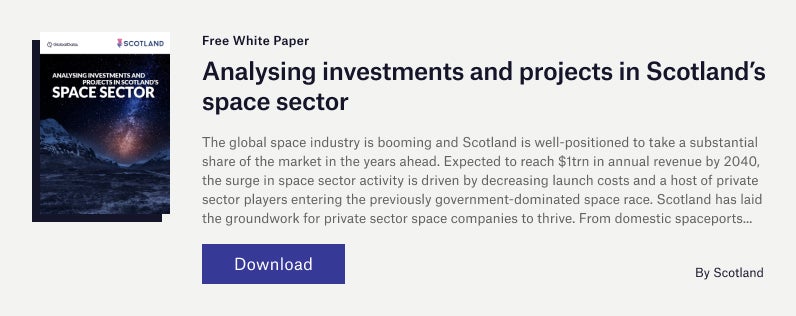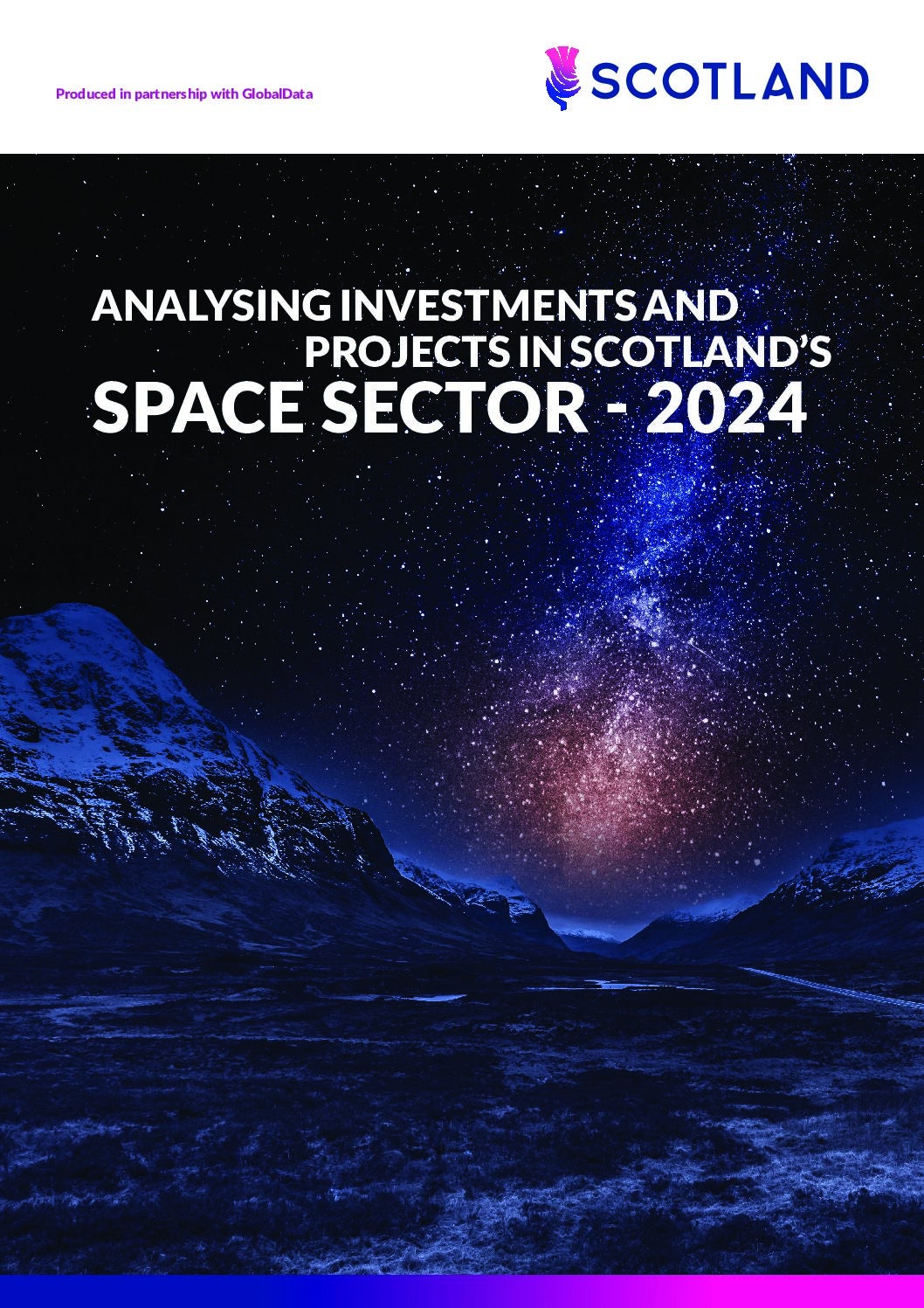
The space sector in Scotland is rapidly building momentum and attracting international attention through its end-to-end capabilities that include talent, research and development expertise, launch services and data analysis.
The global space market is projected to hit $1trn by 2040, and Scotland plans to capture a £4bn market share by 2030. Plans were announced as part of the Scottish Space Strategy at Dubai Expo 2020 in October 2021, with the ambition to position Scotland as a world leader in sustainable space operations on a commercial scale, while attracting inward investments in targeted areas.

Progress is already evident in the number of space businesses in Scotland, which has increased by more than 65% since 2016. By 2030, Space Scotland expects the national sector workforce to increase fivefold.
Once fully operational, the country’s space sector will deliver substantial economic benefits to more areas of Scotland, something that few industries can match. These range from jobs in data and manufacturing in the major cities of Edinburgh and Glasgow to skilled positions at a spaceport and ground station in the most northerly tip of the Shetland Isles.
Despite the five planned spaceports nationally and upscaling of operations, the Scottish Space Sustainability Roadmap is intended to minimise the environmental impact as much as possible to make activities compatible with Scotland’s ambitions to reach net zero by 2045. Measures will include using greener fuels and lightweight materials, minimising waste and promoting reusability.
Many countries have studied what Scotland has been building and are now using the model as a guide for developing their own domestic space sectors.
“What Scotland has done is really impressive,” says Craig Clark, chairman of Space Scotland and professor of practice in space at the University of Strathclyde. “It has been an exemplar to a lot of countries in the world to show what you can do. I think a lot of people look to us and want to replicate it.”
Clyde Space: the catalyst for Scottish space sector growth
Craig Clark is described as a visionary space engineer, and many consider him to be a pioneer of the Scottish space industry. In 2004, Clark set up satellite manufacturer Clyde Space in Glasgow as he wanted to move back to Scotland after leading a power systems team at Surrey Satellite Technology in England for 11 years.
However, Scotland lacked a space sector back in 2004. Seeing the immense potential the country had for space operations, he got into contact with Scottish Enterprise and the Scottish Government, which both provided considerable support in terms of funding and connections with specialists. Clark had never started a company before but very soon found himself leading an organisation of 85 people.
“Clyde Space was challenging the norm as a disruptive technology company. It was creating new market opportunities,” he explains.
Many recognise Clyde Space as the catalyst for the space sector we see today in Scotland. Its presence attracted US satellite manufacturer Spire and then Orbital, with former Clyde Space employees later setting up their own space companies in Scotland. In addition, international space satellite systems manufacturer Celestia UK has set up production facilities in Edinburgh.
“It is quite difficult to gauge how much economic benefit the space sector has given to Scotland,” adds Clark. “It is not just revenue from space companies. It is about the supply chain we have established to support the sector.”
Clark named his company Clyde Space after the River Clyde that runs through Glasgow, which has a history of shipbuilding dating back hundreds of years. He envisioned that Scotland could one day build the spaceships of the future, continuing Scotland’s industrial legacy of engineering and invention.
“The space sector in Scotland is still very young, so who knows where it will go,” Clark says. “It could be even more successful in the future to the point that we are building a large percentage of the world’s spaceships.”
Clark chairs Space Scotland, which seeks to promote the nation’s space sector by focusing on tangible outcomes. The collegiate forum brings together key stakeholders across industry, academia and government regularly via quarterly meetings, as well as working group meetings and ad-hoc work streams.
CubeSats, spaceports rockets and space data
What has changed in recent years is the number of private companies entering the space sector by using CubeSats and small satellites, which weigh less than 500kg and are cheaper to produce than the historically much larger satellites. The impending increase in spaceports and domestically built rockets also means that launches will no longer be restricted to the major spaceports or through international space agencies.
As launch costs drop, the satellite market is becoming busier globally. Projections from Morgan Stanley find that satellite broadband will represent 50% of the projected growth of the global space economy by 2040 – rising by as much as 70% on current figures.
Though small, Scotland is a powerhouse it comes to manufacturing satellites. In fact, Glasgow produces the highest number of small satellites anywhere in Europe.
What provides Scotland with a further advantage for satellite manufacturing is the ability to launch units from domestic spaceports. Scotland’s vast, empty landscapes and proximity to the open ocean make it a highly suitable location for such ports. There are five launch facilities either being built or in the advanced planning stage in Scotland: Space Hub Sutherland in the Highlands; SaxaVord Spaceport in Shetland; Spaceport 1 in the Outer Hebrides; Prestwick Spaceport in Ayrshire; and Spaceport Machrihanish in Argyll, western Scotland.
Such is the demand for launches at SaxaVord in Shetland, for example, that operators are having to build additional launchpads. They were originally going to be three, but this will now increase to five because of the volume of requests.
To further Scotland’s space capabilities, rockets are also being manufactured domestically. Orbex has recently secured funding of £40.4m to develop rockets for launch at Spaceport Sutherland. One financial backer is the Scottish National Investment Bank (SNIB), with another being Jacobs, a service provider to Nasa.

Furthermore, the ability to capture and analyse satellite data domestically is another advantage for Scotland’s space economy. Edinburgh-based Trade in Space operates at the intersection of Earth observation and blockchain technologies. The Scottish fintech uses space data, machine learning and blockchain technology to inform and facilitate agricultural commodities trading with clients on the other side of the world.
With 170 data science companies based in Edinburgh alone, more than 130 space organisations and 83 aerospace companies in Scotland, recent graduates are unlikely to be short of offers in the local job market.
“What we have in Scotland is a natural cluster of space companies working together, communicating and helping each other to grow,” adds Clark.
The next generation of space talent
An integral part of Scotland’s space sector is the country’s network of world-renowned universities and institutes, where satellites and technologies are developed, and vital research takes place.
The Scottish Universities Physics Alliance is a project among the country’s leading universities, ensuring Scotland continues to produce cutting-edge physics research. Furthermore, the University of Strathclyde’s space cluster works with industry partners to conduct research and train talent.
For the younger generation, the University of Strathclyde’s Scottish Space School sees 80 students attend a week-long summer programme to engage the next generation of space talent.
“The quality of the universities, given how small Scotland is, is unique. It makes a massive difference,” explains Clark. “I have always been a big fan of working with universities.
“When I was with Clyde Space, I always had a relationship with Glasgow, Strathclyde, and other universities as well, not only for talent but also for running projects. We would run a PhD, an EngD or other projects to develop new technology, because that is what helps ensure the companies are competitive in future.
“We need to make sure that they are making the most of the fact that these institutions are on our doorstep in the UK.”
Universities are also essential in attracting businesses interested in collaborating in the space sector, as well as for spinning out new companies from university departments, while several space start-ups have been founded by students in Scotland through their courses.
However, while many satellites are currently produced by universities in the US, Clark would like to see this increase in Scotland. The launch capabilities Scotland is developing will bring this a step closer.
“I think that is a great model. There are things we are doing in Scotland to have more universities building satellites,” he says.
“Now that we have this launch capability coming through in the new year or two, we should have satellite building competitions for universities every year – and the prize is you get to launch it into space. That would be great for the sector, promoting skills and talent, while getting more people engaged.”
With its spaceports in development, universities that produce research and talent, and network of companies that can capture and interpret space data, Scotland is uniquely positioned to be at the frontier of the space economy and is firmly on track to achieve its ambition of a £4bn market share by 2030.
“We have come such a long way and it shows you how vibrant, energetic and ambitious the sector is,” adds Clark. “That is what is really exciting for me.”
To learn more about the investments and projects in Scotland’s space sector, download the specially commissioned white paper on this page.



